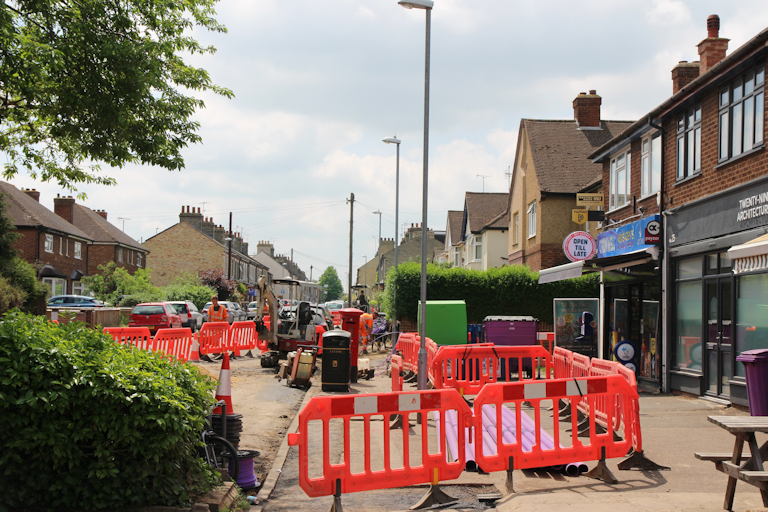Broadband in Cambridge city may be carried over one of four physical networks. These are outlined here. The services offered by ISPs are beyond the scope of these notes.
Virgin Media
Cambridge had a first-generation “British Relay” cable network from the 1960s, which provided four(!) TV channels and four radio stations. It wasn’t expandable and closed down in the early 1980s. It had gone by the time I arrived here in 1984 as a student. There’s some information about it. in the Arbury Cambridge Blog.
Cambridge Cable (later NTL then Virgin Media) constructed the current hybrid fibre-coaxial (HFC) cable network in 1991, radiating out from its premises off Ainsworth Street. It covered Coleridge and Romsey entirely, but since then “notspots” have arisen where developers of new properties didn’t get them connected during construction. Their residents were stuck with Openreach “copper broadband” until Openreach or CityFibre offered fibre-to-the-premises (FTTP) connections there.
In those analogue, pre-internet days cable carried about 40 TV channels and 20 FM radio stations, received on big satellite dishes and an antenna tower beside the railway line (still there on Google Earth), along with landline phone. Now it’s just a node on a national digital network, although I gather it can still pick up at least the 5 main national TV stations locally if that goes down.
In 1991 it was envisaged future telecommunications would need FTTP and the coaxial cables would be long gone by now, so construction was done cheaply. However there’s no need to replace them yet as they can deliver reliable gigabit broadband alongside 400-odd digital TV and radio channels. Virgin Media has been using FTTP where expanding its network into new areas since at least the early 2020s.
As of 2025 there are still lots of these plastic cabinets around, many the worse for wear. The damage shown above caused a total broadband and cable TV failure here after about a week, but I’d already reported it and they repaired it the next morning.
They have started to install smaller, metal cabinets alongside many of these. My guess is that these will replace them when they switch off the analogue phone exchange and move everyone to VoIP, currently expected in early 2027. Then they can cut back all the phone lines and use the new cabinets to connect only the coaxial cables.
Already, if you order a Virgin Media phone line where there isn’t one already, or if a fault develops that is tedious for them to fix, they connect you over VoIP using phone sockets on the cable modem router instead.
CityFibre
CityFibre laid its new FTTP network in Cambridge in the early 2020s and as of 2025 is expanding it in surrounding areas. In 2021 I found construction underway in parts of Coleridge, Romsey and Petersfield.
I encountered the above when I went to explore the construction of the Chisholm Trail. Purple is apparently a new colour for underground services in a national scheme. In case you want to know who’s digging up your road or holding up the traffic, it is:
| Black | Premises (230V) electricity | Red | High voltage power distribution |
| Orange | Street infrastructure (lighting and traffic signals) | Yellow | Gas |
| Green | Cable telecommunications, notably Virgin Media, and CCTV | Blue | Water |
| Purple | CityFibre | Grey | Openreach |
| Terracotta | Sewerage | Metal | Beware as gas unless you know otherwise! |
Like Openreach but unlike Virgin Media, the CityFibre network is provided wholesale to third-party service providers. Initially they offered service in a launch partnership with Vodafone, then opened their network up to other providers after a year. Some of these offer VoIP telephony via their broadband routers, and you can port your existing 01223 number from BT or Virgin Media.
Openreach
Openreach is expanding its use of FTTP, but older connections use fibre-to-the-cabinet (FTTC) with copper telephone lines providing DSL connections to end users. The latest generation of that is called G.fast and offers speeds of up to about 300Mb/s. Various service providers offer broadband using Openreach.
Their network leads from the “Cherry Hinton Exchange” building in Coleridge Road. They have an exchange elsewhere serving the city centre. It used to (and may still) be the case that if you moved home to the other side of the railway line you had to change your BT phone number, whereas Virgin Media numbers can be moved anywhere within the 01223 code area.
As with Virgin Media, switch-off of the BT analogue landline exchange and migration to VoIP over broadband connections is expected in early 2027.
Granta Backbone Network
In the early 1990s, Cambridge University constructed its own private optical fibre network, the Granta Backbone Network (GBN), linking all its city campuses and colleges. There was some collaboration with Cambridge Cable, who were constructing their cable network at the same time, to enable the ducts for both to be laid together in common trenches, in some cases across University land.
In the years since, the GBN has grown to serve other academic institutions such as Anglia Ruskin University, parts of the Addenbrooke’s Campus and the Council, shown on its Tube-style schematic map. There’s a YouTube lecture here about its history and lessons learned from building it. It says the University would have preferred not to create its own network, but none of the utility companies were willing to provide dark fibres between all its sites as opposed to managed services, and that remains the case.




